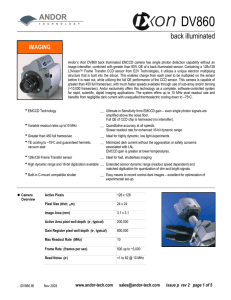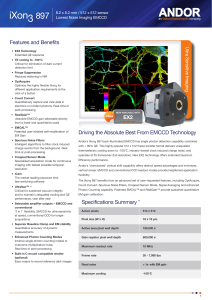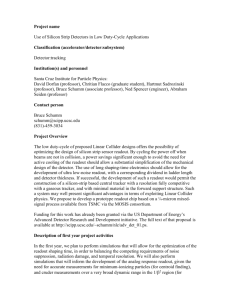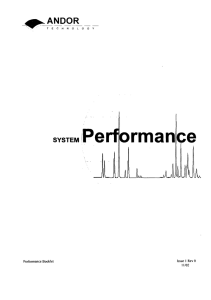DV860 (back illuminated) EM
advertisement
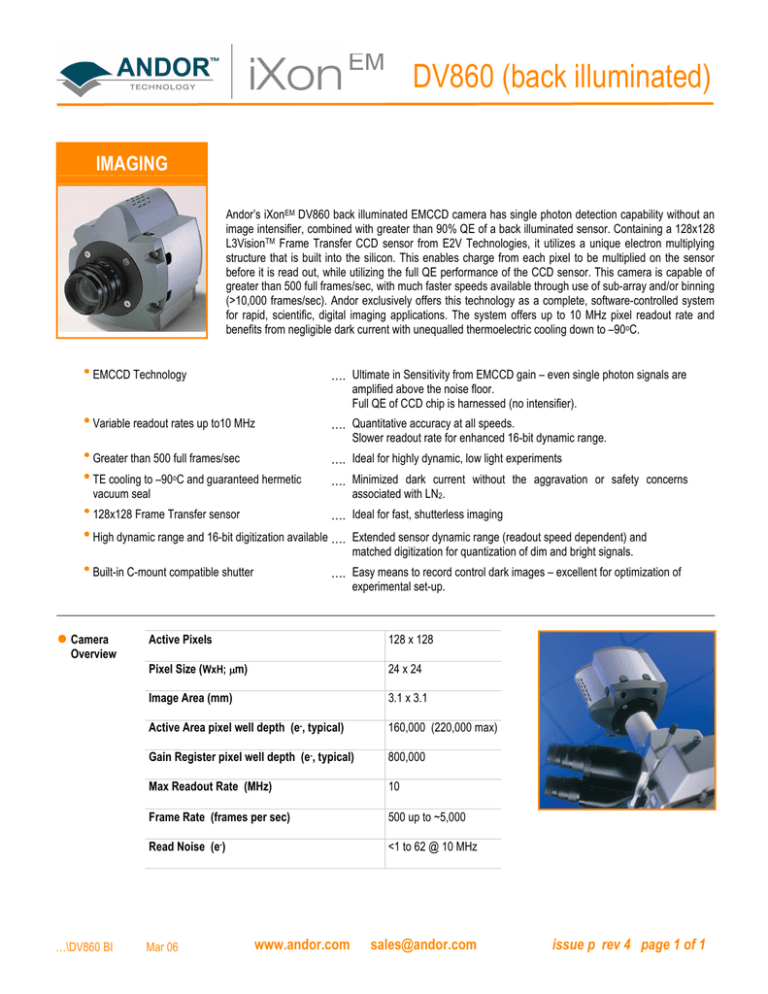
EM DV860 (back illuminated) IMAGING Andor’s iXonEM DV860 back illuminated EMCCD camera has single photon detection capability without an image intensifier, combined with greater than 90% QE of a back illuminated sensor. Containing a 128x128 L3VisionTM Frame Transfer CCD sensor from E2V Technologies, it utilizes a unique electron multiplying structure that is built into the silicon. This enables charge from each pixel to be multiplied on the sensor before it is read out, while utilizing the full QE performance of the CCD sensor. This camera is capable of greater than 500 full frames/sec, with much faster speeds available through use of sub-array and/or binning (>10,000 frames/sec). Andor exclusively offers this technology as a complete, software-controlled system for rapid, scientific, digital imaging applications. The system offers up to 10 MHz pixel readout rate and benefits from negligible dark current with unequalled thermoelectric cooling down to –90oC. EMCCD Technology …. Ultimate in Sensitivity from EMCCD gain – even single photon signals are amplified above the noise floor. Full QE of CCD chip is harnessed (no intensifier). Variable readout rates up to10 MHz …. Quantitative accuracy at all speeds. Slower readout rate for enhanced 16-bit dynamic range. Greater than 500 full frames/sec TE cooling to vacuum seal –90oC …. Ideal for highly dynamic, low light experiments and guaranteed hermetic …. Minimized dark current without the aggravation or safety concerns associated with LN2. 128x128 Frame Transfer sensor High dynamic range and 16-bit digitization available …. Extended sensor dynamic range (readout speed dependent) and matched digitization for quantization of dim and bright signals. Built-in C-mount compatible shutter …. Ideal for fast, shutterless imaging …. Easy means to record control dark images – excellent for optimization of experimental set-up. Camera Overview …\DV860 BI Active Pixels 128 x 128 Pixel Size (WxH; µm) 24 x 24 Image Area (mm) 3.1 x 3.1 Active Area pixel well depth (e-, typical) 160,000 (220,000 max) Gain Register pixel well depth (e-, typical) 800,000 Max Readout Rate (MHz) 10 Frame Rate (frames per sec) 500 up to ~5,000 Read Noise (e-) <1 to 62 @ 10 MHz Mar 06 www.andor.com sales@andor.com issue p rev 4 page 1 of 1m EM DV860 (back illuminated) System Pixel Readout Rate (MHz) Characteristics Linearity (%, maximum) ♦1 Vertical Clock Speed (µs) Electron Multiplier Gain (software controlled) Digitization @ 10, 5, 3 & 1 MHz readout rate Dark Current @ -70 oC (e-/pix/sec) ♦2 @ -90 oC (e-/pix/sec) Camera window type 10, 5, 3, 1 1 0.1 to 6 (variable) 1 – 1000 times 14-bit (16-bit available @ 1MHz) 0.02 0.004 Single window with double-sided AR coating – standard for BV model Noise Typical 62 45 22 System Readout Noise (typical; e-) ♦3 10MHz through EMCCD amplifier 5MHz through EMCCD amplifier 1MHz (16-bit) through EMCCD amplifier Noise & EMCCD Gain with Electron Multiplication <1 <1 <1 Minimum Temperature (°C) Variation of Readout Noise with EMCCD Gain at 10MHz Readout Rate Effective Read Noise (e-) 100 10 1 0.1 Air-cooled (ambient air @ 20°C) -70 Re-circulator (RC180) (ambient air @ 20°C) -85 Water-cooled (@ 10°C, 0.75 l / min) -90 0.01 0 100 200 300 400 500 600 700 800 900 1000 EMCCD Gain Peak Quantum Efficiency at –20°°C temperature (%) ♦4 o Quantum Efficiency for the back illuminated iXon camera at -20 C Quantum Efficiency Quantum Efficiency (%). 100 90 BV 80 UVB 70 CCD Type Minimum BV @ 575 nm 82 Typical 92.5 UVB 92.5 60 50 @ 575 nm 82 40 30 20 10 0 200 300 400 500 600 700 800 900 1000 Wavelength (nm) …\DV860 BI Mar 06 www.andor.com sales@andor.com issue p rev 4 page 2 of 2m EM Max Frames per sec ♦5 • • DV860 (back illuminated) full frame rate of 500 frames per sec at 10MHz readout rate and 0.1µs vertical clock speed frame rates up to about 5,000 frames per sec are possible by the selection of smaller sub-arrays and shorter vertical shift speeds. Full Frame Rate ♦6 Power Requirements ♦7 No. frames per sec 500 400 0.6A @ +12V 0.3A @ -12V 3.0A @ +5V 300 200 100 0 1 2 3 4 5 6 7 8 9 10 Readout Rate / MHz Operating & Storage Conditions 0oC to 30oC ambient < 70% (non-condensing) -25oC to 55oC Operating Temperature Relative Humidity Storage Temperature Computer To handle data transfer rates of 10MHz readout over extended Requirements kinetic series, a powerful computer is recommended, e.g: • 3 GHz Pentium (or better) • 1GB RAM • 10,000rpm SATA hard drive preferred for extended kinetic series …\DV860 BI Mar 06 www.andor.com Also: • PCI-compatible computer • PCI slot must have bus master capability • Available auxiliary internal power connector • 32 Mbytes free hard disc sales@andor.com issue p rev 4 page 3 of 3m EM DV860 (back illuminated) Weight: 3.1 Kg [7 lb 1 oz] 173.9 [6.9"] Dimensions in mm unless otherwise indicated. 90.45 [3.6"] 98.0 [3.9"] 50.8 [2.0"] 69.0 [2.7"] 138.0 [5.4"] 76.2 [3.0"] Pair of Mounting Holes Note: The clearance from the C-mount face plate to the shutter is 6mm. Please ensure that when fitting a lens, to a system with a built in shutter, that it does not extend into the housing by more than 5mm. …\DV860 BI Mar 06 www.andor.com Note: There are mounting holes (1/420UNC) located on three sides of the camera. They are positioned centrally at a distance of 40mm from the front of the front face. sales@andor.com issue p rev 4 page 4 of 4m EM Ordering Information DV860 (back illuminated) Camera Model Number To order this camera quote part number: DV860 x CS – x Digitization option: D = 10, 5, 3 & 1 MHz readout at 14 bit E = 10, 5, & 3 MHz readout at 14 bit and 1MHz at 16 bit Sensor finish option: BV = standard back illuminated device UVB = back illuminated device with UV coating Shutter option: S = standard built in shutter no entry = no shutter Lens mount option: C = C-mount (other lens mounts available on enquiry) e.g. DV860DCS–UVB a back illuminated iXonEM DV860 camera with 14-bit digitization at 10, 5, 3 and 1MHz readout speeds, EMCCD output amplifier, standard shutter and UV enhanced coating. The iXonEM DV860 requires the following controller card: CCI-22 PCI controller card The iXonEM DV860 also requires one of the following software options: Andor MCD – a ready-to-run Windows 95, 98, 2000, ME, NT or XP -based package with rich functionality for data acquisition and processing Andor-SDK-CCD – a DLL driver and software development kit that let you create your own applications for the Andor camera. Andor iQ – a comprehensive multi-dimensional imaging software package. Offers tight synchronization of EMCCD with other microscopy hardware, along with comprehensive rendering and analysis functionality. Modular architecture for best price/performance package on the market. Third party software compatibility – Drivers are available so that the iXonEM range can be operated through a large variety of third party imaging packages. Contact Andor for further details The iXonEM DV860 may be used with the following accessories: OPTION-C1-LM-C C-mount lens adaptor (other mounts available on request) XW-RECR Recirculator for enhanced cooling performance XW-CHIL-150 Ultra-compact chiller unit for ultimate cooling performance REMOTE CTRL KIT Programmable remote control for controlling functions from anywhere around the optical set-up Contact Andor for any of your custom requirements. (Contact details on back page) …\DV860 BI Mar 06 www.andor.com sales@andor.com issue p rev 4 page 5 of 5m EM DV860 (back illuminated) NOTE - Specifications are subject to change without notice. ♦1 Linearity is measured from a plot of Signal vs. Exposure Time over the 14 or 16 bit dynamic range. Linearity is expressed as a percentage deviation from a straight line fit. This value is not measured on individual systems. ♦2 The dark current measurement is averaged over the CCD area excluding any regions of blemishes. ♦3 System Readout noise is for the entire system. It is a combination of CCD readout noise and A/D noise. Measurement is for Single Pixel readout with the CCD at a temperature of -50°C and minimum exposure time under dark conditions. Under Electron Multiplying conditions, the effective system readout noise is reduced to sub 1e- levels. Noise values will change with pre-amplifier gain (PAG) selection. Values quoted are measured with highest available PAG setting. ♦4 Quantum efficiency of the CCD sensor as measured by the CCD Manufacturer. ♦5 The max frames / second for iXonEM imaging CCDs is the maximum speed at which the device can acquire images in a standard system. Assumes internal trigger mode of operation. ♦6 The graph shows the full frame rates possible when reading out the sensor at 10, 5, 3 and 1 MHz pixel readout rates, and using 0.9µs vertical clock speed. ♦7 These power requirements are the maximum load that will be drawn from the computer for the camera head and controller card combined. Need more information? Contact us at: US Office Phone (860) 290-9211 Fax (860) 290-9566 …\DV860 BI Mar 06 International Office Phone +44 28 9023 7126 Fax +44 28 9031 0792 www.andor.com sales@andor.com Japanese Office Phone +81 3 3511 0659 Fax +81 3 3511 0662 issue p rev 4 page 6 of 6m
